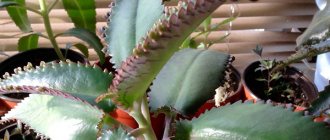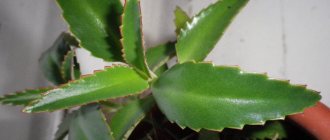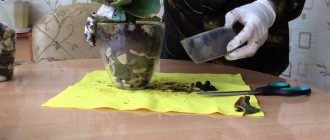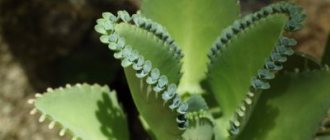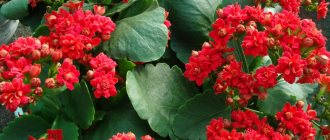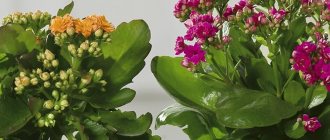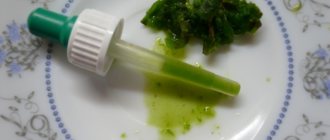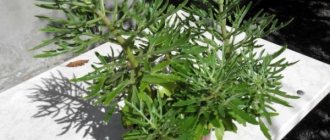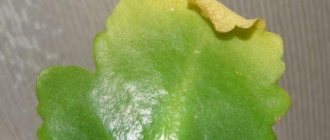Description of the plant
Kalanchoe belongs to the group of succulents. The flower does not grow in the wild, as it was bred by breeders. Other types of plants can be seen in nature on almost all continents of the globe.
Kalandiva is a particularly decorative flower, which is noted for its long and abundant flowering. This is a compact bush that has fairly thick stems. The flower is characterized by the presence of neat fleshy leaves, which are not deprived of smoothness or velvety. The height of the bush does not exceed 30 cm.
The plant is distinguished by the presence of short peduncles on which inflorescences of small double flowers are located. They are distinguished by a variety of colors.
The flowers of the plant can be pink, red, salmon, yellow.
Flowering Kalanchoe is a short-day crop. The plant will bloom only if the light regime is strictly observed. The culture is characterized by abundant flowering, which can be observed for 6 months. In most cases, Kalanchoe blooms in mid-winter.
Important! From mid-summer, a dormant period begins, which is characterized by mild expression. That is why Kalanchoe kalandiva does not need special care at this time.
Kalanchoe calandiva is a rather attractive flower that can decorate the design of any room with original blooms.
Description of varieties of calandiva
Kalanchoe calandiva is a 30 cm tall bush with fleshy stems and dense leaves. The leaves of the plant are smooth or velvety, depending on the variety. Small double flowers are connected into fluffy inflorescences. Calandivas differ from each other mainly in the color of their petals. Kalanchoe mix is especially popular, as it is a hybrid with inflorescences of different colors. The plant has some medicinal properties, but is grown mainly as an ornamental flower. To add color to your home greenhouse, purchase several Kalanchoes with flowers of different colors.
Rapidly blooming mini variety
Proper care of mini calandiva guarantees luxurious flowering. The first flowers appear a few months after planting and last about 4 weeks. Then the flowers dry out and fall off, and new buds develop in their place. The full flowering cycle lasts 6 months. Dense stems hold fleshy leaves. The flowers are collected in umbrellas, the petals can be yellow, pink, purple, red, white, orange.
Multi-colored hybrid mix
Kalandiva mix is a hybrid variety that was bred on the basis of mini Kalandiva. The mix blooms almost all year - 8 months, excluding the time of vegetative dormancy. The miniature plant pleases the owner with colorful flowering. The inflorescences come in red, yellow, lilac and white. Kalanchoe leaves are smooth, dark green, oval in shape with wavy edges. Sometimes flower shop owners call calandiva a mix of several Mini plants planted in one pot.
Popular varieties
There are several varieties of Kalanchoe. The most popular of them include:
- Mix. This is a universal plant that in appearance resembles a miniature bush. The uniqueness of this culture lies in the fact that it has flowers of different colors.
- Mini. This flower belongs to the category of tenacious and undemanding plants. It is characterized by the presence of thick and rounded stems. Thanks to the good branching of numerous shoots, the appearance of the flower resembles a miniature bush.
Due to the presence of several varieties of flowers, it is possible to choose the most suitable option for a person.
If you provide proper care at home, Kalanchoe Kalandiva mix and mini will delight all gardeners with their appearance.
Growing conditions
In order to ensure the full growth and development of Kalanchoe, it is necessary to create appropriate growing conditions.
| Conditions | Security |
| Lighting | The culture needs bright, diffused lighting throughout the year. That is why it is recommended to place it on a western or eastern window. Despite the fact that Kalanchoe calandiva blooms in winter, this flower is a short-day plant. That is why in cloudy weather there is a need for additional lighting. To avoid burns on the foliage of the plant, it is necessary to limit its exposure to direct sunlight. |
| Temperature | In the summer, the plant is grown at fairly high temperatures with an indicator of 18-30 degrees. In winter, the temperature must necessarily drop to 14-16 degrees. Thanks to this regime, new kidneys will be formed. Otherwise, Kalanchoe calandiva will not bloom. |
| Humidity | The flower does not need to artificially increase humidity, since it is able to fully grow in dry air. Despite this, it is recommended to periodically bathe the flower in water at room temperature, which will make it possible to wash off dust from the foliage. |
Kalanchoe calandiva is an unpretentious flower. He just needs to provide comfortable growing conditions.
Causes of drying and falling leaves
During the heating season, the tips of Kalanchoe leaves often dry out.
This is due to low air humidity, which the plant does not tolerate well. It is necessary to keep the pot away from the radiator and fireplace. If the leaves begin to turn yellow and crumble, the bush does not have enough nutrition. From late spring to early autumn it needs to be fed with mineral complexes for succulents. In this case, use a concentration 2 times lower than the recommended one.
Foliage also dries out due to too bright lighting. In summer, the best place for Kalanchoe is an eastern window.
Planting and transplanting
The flower must be replanted annually in a new soil mixture. In order to change unsuitable soil, after purchasing Kalanchoe Kalandiva, it is necessary to replant. This will create optimal conditions for growing the flower.
When planting and replanting Kalanchoe kalandiva, a rather important aspect is the selection of the pot. When purchasing a new pot, you need to ensure that its diameter is several centimeters larger than the previous one.
If an old pot is used to transplant calandiva, it must first be thoroughly washed with soap. When using a new pot, it is recommended to immerse it in boiling water for a few minutes. To disinfect dishes, use a weak solution of potassium permanganate.
It is imperative to lay a drainage layer at the bottom of the pot. It could be:
- expanded clay;
- coarse sand;
- clay shards.
A quarter of the pot must be filled with drainage. To plant Kalanchoe, you can use a ready-made soil mixture or make it yourself. It consists of sand, peat and turf soil. The soil mixture is poured over the drainage using the method of forming a mound. It is necessary to place the roots of the culture on it.
Note! Before planting a plant, it is necessary to inspect its root system. If there are diseased and rotten roots, they must be trimmed.
Planting and replanting Kalanchoe kalandiva is the simplest procedure that any gardener can easily carry out.
Transfer
You can replant a plant for the first time 7-10 days after its acquisition, when it is completely acclimatized to its new conditions. The process is not difficult even for an inexperienced gardener. The soil where the plant is located must be moistened, the flower must be removed from the old pot and moved to a new habitat, adding nutritious soil to the required volume. The new pot should be 2-3 centimeters wider than the previous one. A drainage layer must be placed at the bottom.
Plants under 3 years old need annual replanting. For more mature flowers, one transplant every 3 years is sufficient.
Home care
In order to ensure normal growth and abundant flowering of Kalanchoe kalandiva, it must be properly cared for. The plant must be watered, fed, and pruned.
Watering and fertilizing
The plant needs moderate watering. If there is an excess of moisture, rotting of the root system and death of the crop may occur. The plant's watering regime is determined by the condition of the soil. Watering is carried out if the soil has dried out to a depth of several centimeters. If the room temperature decreases, this requires reducing the frequency of watering.
Attention! If there is lethargy of the plant’s foliage, it needs to be watered more often.
The plant is fed with mineral and organic fertilizers, which should alternate. The florist should know that fertilizing should be moderate, especially when using nitrogen-containing substances.
During the dormant period, they must be kept to a minimum, since green mass will grow on Kalanchoe kalandiva, which will lead to a lack of flowering. After the buds appear on the flower, potassium and phosphorus must be added underneath it. During this period, you can use ready-made mixtures for cacti to feed plants.
Feeding and watering Kalanchoe kalandiva is a necessary procedure to ensure full flowering.
Flowering period
The plant blooms once a year. In order to create an additional flowering period, Kalanchoe kalandiva is provided with an artificial play of light.
With additional lighting, the flowering time of the crop is much longer. If the flower does not open its buds at the specified time, then it must be checked for the presence of pests and diseases.
Rest period
The plant is unpretentious. That is why Kalanchoe kalandiva does not need special care at home during the dormant period. At this time, you just need to reduce the frequency of watering. Lighting should be less bright.
Plant pruning
Kalanchoe belongs to the category of fast-growing flowers. Over the course of a year, it can significantly increase in size, which will lead to loss of bush shape. After Kalanchoe blooms, the loss of its lower leaves is observed. That is why, after Kalanchoe calandiva has faded, deep pruning is carried out.
If the flower is young, then its foliage is pinched. Kalanchoes with a sufficiently developed root system are pruned almost completely.
Video: how to pinch Kalanchoe kalandiva.
Pests of Kalanchoe
Pests on this flower appear much less frequently than diseases, but this phenomenon still occurs. Insect pests of Kalanchoe include aphids, scale insects, mites and mealybugs. All of them suck the juice from the plant, weakening its strength and making it defenseless against other threats.
Mealybug
A small insect that, in the course of its life, deprives the plant of juice. The second negative factor is the spread of the fungus “black mold”. The development of the colony occurs quite quickly, so if measures are not taken in time, the Kalanchoe will die.
A characteristic sign of the presence of a pest is a waxy coating present on the leaf blade and stems. The fight is to use mineral oil for spraying. If one of the branches is heavily infected, it is better to remove it. It is important to check the plant and soil for pests before purchasing.
Shchitovka
The insect has an oblong body covered with a shield. Males are smaller than females, which, in principle, do not move, but only cover their eggs. A characteristic sign of the appearance of the pest is the plaque and the scale insects themselves, since they are quite large in size and clearly visible to the naked eye.
The spread of scale insects throughout the plant is the reason why Kalanchoe withers. In the future, the leaves will turn yellow and fall off, the flower will slow down its growth and stop throwing out flower stalks. The presence of this pest can provoke the appearance of sooty fungus, which will further aggravate the situation.
The fight consists of frequent spraying of the plant, because... The scale insect does not like water. Adults are treated with alcohol to improve separation from the leaf, then collected. After this, the flower is sprayed with a soap solution. Instead, insecticides can be used to control pests. Generally effective drugs are suitable, since there are no separate developments.
Aphid
This insect very often attacks Kalanchoe, because it can get into the house on other flowers or simply fly into the window. Aphids are located on the underside of the leaf, appearing as small black or green dots. During its life, the pest sucks out the juice and injects poison into the flower. In addition, it coats the plant with a sticky substance that blocks the pores and prevents the foliage from breathing.
It is important to know how to get rid of aphids on Kalanchoe, otherwise the flower will soon die. The plant should be periodically inspected for pests and monitored for deformation and yellowing.
The first step in the fight is to remove the damaged areas along with the colonies. The remaining branches and leaves are treated with insecticides - 4 times during the month. A more gentle solution would be potassium soap: dilute 20 g in 1 liter of water. The resulting solution is used to wash the plant; before the procedure, the soil should be covered. If you don’t have potassium soap, household soap will do - it’s not as effective, but it will also help cope with the task.
Ticks
Sucking insects that live on the underside of the leaf blade. Recognized by the appearance of cobwebs. They prefer warm and dry air. The appearance of the pest on the plant is reflected in the yellowing of the leaves, which subsequently harden and curl.
You can get rid of ticks using the same methods as aphids. Spraying is carried out with Akarin, Fitoverm and the like.
Diseases and pests
The undeniable advantage of the flower is that it is practically not affected by pests. If Kalanchoe kalandiva is not properly cared for at home, various diseases can develop.
| Name | Control measures |
| Late blight rot | During the course of this disease, brown spots are observed on the foliage of Kalanchoe calandiva. Fungicides are used to treat the disease. In this case, it is recommended to reduce watering, as well as replace the soil mixture in the pot. |
| Gray rot | With this disease, a gray coating is observed on the foliage, as well as weeping spots. Treatment of the disease requires treating the flower with appropriate compounds, which can be purchased at a specialty store. |
| Ring spot | The disease is characterized by the appearance of spots on the foliage that resemble rings in shape. This disease cannot be cured. This is why plants are destroyed. |
| Powdery mildew | During the course of this disease, a white coating appears on the leaves of the flower. If the disease is not treated in a timely manner, gradual death of the foliage is observed. In most cases, the disease occurs due to excessive dryness and elevated temperature. The plant must be treated by spraying, which uses fungicides that are sold in flower shops. |
Kalanchoe can succumb to a variety of diseases. In order to eliminate the possibility of their occurrence, it is necessary to carry out timely prevention. It consists in maintaining optimal conditions and providing complete care for Kalanchoe kalandiva.
Reproduction methods
For propagation of Kalanchoe calandiva, cuttings and leaves are used in most cases. They are cut from the main plant and dried for 2 hours. After this, the leaf or cutting must be placed in a substrate for rooting.
Some gardeners place them in water. In order for the plant to quickly take root, it must be germinated in sand. After planting a leaf, flowering will be observed after a year, and a cutting – after 6 months.
Kalanchoe calandiva can be propagated by seeds. They are very small in size and look like dust. Seeds are planted on the surface of the soil. You should not sprinkle them with soil mixture, as they will not have enough strength to germinate.
Important! To plant seeds, soil and sand are used, which are pre-sifted.
The container with seeds must be covered with plastic wrap or a piece of glass. The soil is moistened from the pallet. After 1-2 weeks, the first shoots will appear. After 7 days, it is necessary to carry out the first picking of the plant. When crops come into contact with their leaves, repeated picking is carried out. During this period, seedlings are planted in separate pots.
Kalanchoe calandiva is a unique flower that can be grown in an apartment, house or public premises. Due to the fact that Kalanchoe kalandiva requires minimal care at home, even an inexperienced gardener can do it. Subject to all conditions and rules of care, long and lush flowering of Kalanchoe kalandiva will be ensured.
How to revive Kalanchoe with limp leaves
A healthy plant has leaves that are hard and elastic and grow almost perpendicular to the stem. If they become limp, sagging and begin to crumble, this may indicate that:
- The soil in the pot is too dry. Even succulents cannot go without water for a long time, especially young bushes. At first they make do with their own, albeit small, forces, but when the moisture reserves are depleted, the flower begins to fade. You urgently need to water the plant, but without fanaticism - everything that flows into the pan must be drained. The very next day the leaves will again be hard and sticking out to the sides.
- The flower was caught in a draft or the temperature in the room dropped sharply. Although Kalanchoe does not particularly like heat and sun, it does not like low temperatures and cold air flows. Move the pot to a window that does not open, and after a while the bush will restore turgor.
- The root system is rotten. The reason for this is definitely excess moisture. Constantly wet soil for a flower means death, because putrefactive processes actively begin to develop in the soil. First the roots rot, then the above-ground part suffers. The leaves will become limp, spots may appear on them, and over time even massive leaf fall will begin. Such a bush can only be saved by replanting and thorough cleaning. All parts of the plant infected with rot should be cut off, get rid of the old soil and plant in fresh substrate. To prevent further development of rot, the plant must be treated with a fungicide.
If the Kalanchoe is affected by root rot and the disease has already appeared as spots on the leaves, it is better not to risk it and throw it away. If possible, you can root a healthy apical cutting, which the fungus has not yet reached, but also treat it with a fungicide.
